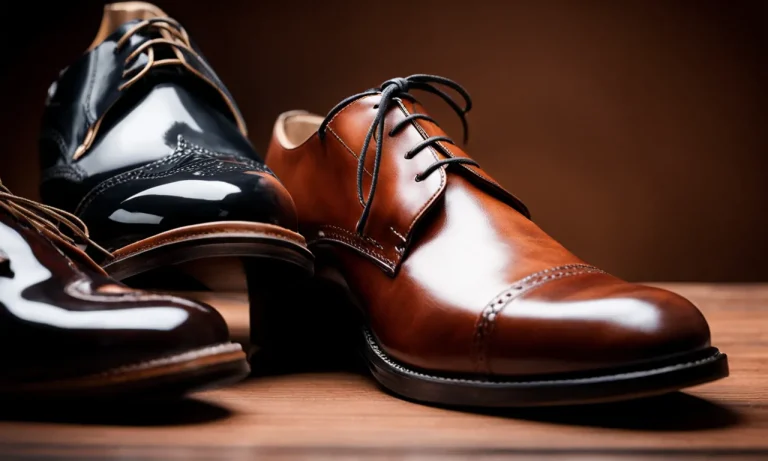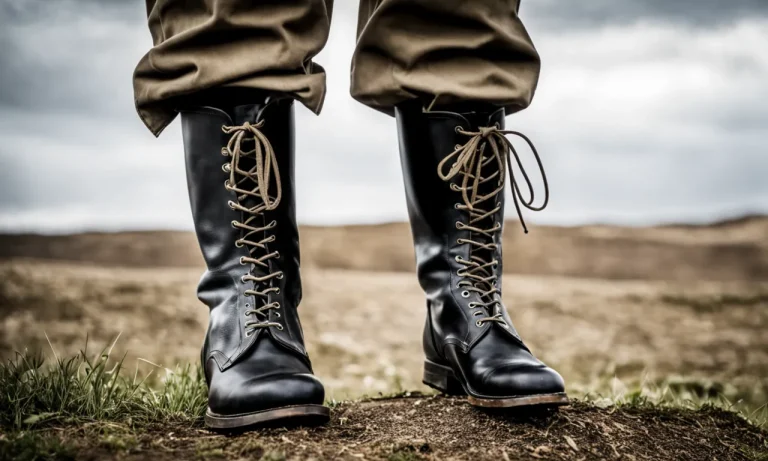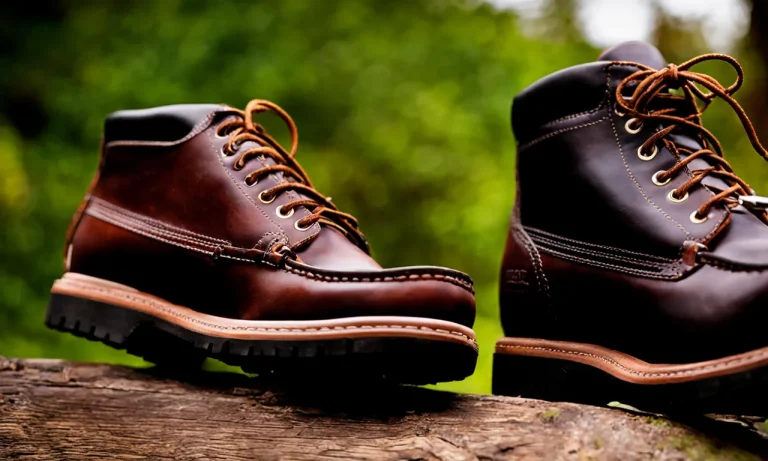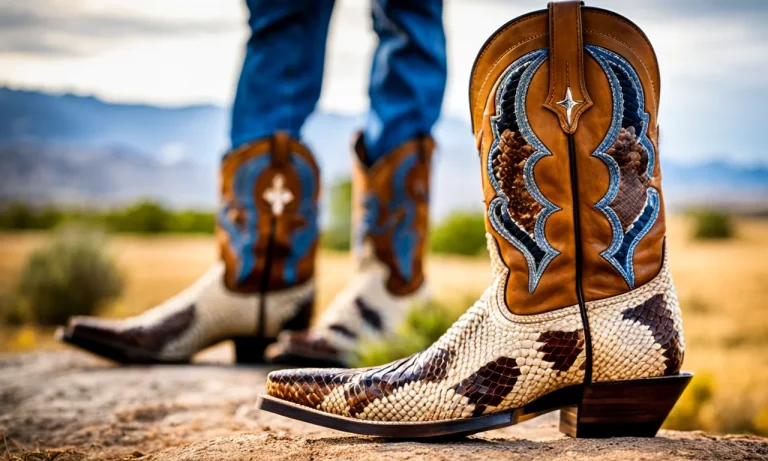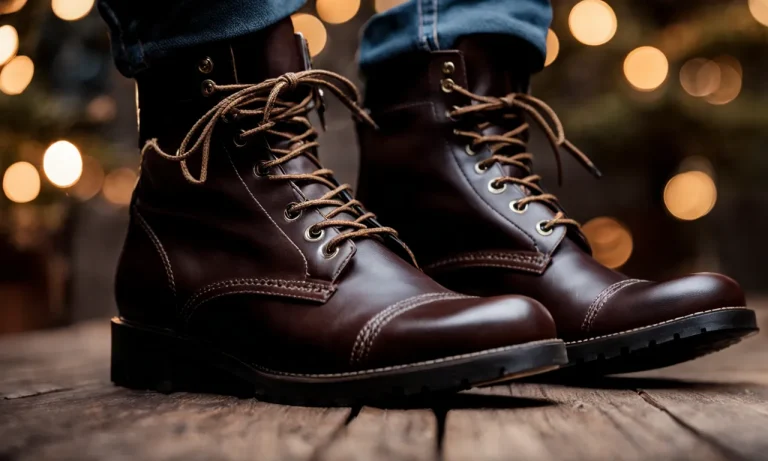If you’ve ever seen a cowboy or cowgirl wearing boots with those pointy metal pieces on the back, you were looking at spurs. Spurs have been around nearly as long as riding boots themselves. Read on to learn all about the origins and purpose of spurs on boots.
If you’re short on time, here’s a quick answer to your question: Spurs on boots are used by riders to cue their horses to move or change direction. The spurs provide an extension to the rider’s leg and heel that allows them to gently signal the horse by applying pressure with their heel.
What Are Spurs?
Spurs are a metal tool that attaches to the heel of a boot. They have been used for centuries by horse riders to communicate their commands to the horse more effectively. The word “spur” comes from the Old English word “spura” which means “to kick.”
A metal tool that attaches to the heel of a boot
Spurs are typically made of metal, such as stainless steel or brass, but they can also be made of other materials like plastic or rubber. The design of the spur consists of a long shank that extends from the heel of the boot, ending in a small wheel called a rowel or a point.
The rowel can have various numbers of points, with each point serving a different purpose.
Usually made of metal but can be other materials too
In the past, spurs were primarily made of iron, but as technology advanced, different metals were introduced to make them more durable and lightweight. Today, riders can choose from a wide range of materials and designs to suit their needs and preferences.
Some spurs even have decorative elements, making them a fashion statement in addition to a functional tool.
Comes to a point or has a small wheel called a rowel at the end
The end of the spur can either come to a sharp point or have a small wheel called a rowel. The rowel can have multiple points or be smooth. The choice of rowel depends on the rider’s discipline and personal preference.
A pointed spur is usually used for more precise and direct cues, while a roweled spur provides a less severe and more subtle aid.
It is important to note that the use of spurs requires skill and proper training to ensure the comfort and safety of both the rider and the horse. Riders should always use spurs responsibly and with respect for the horse’s well-being.
History and Origins of Spurs
Spurs date back thousands of years to when humans first domesticated horses
The use of spurs can be traced back to the early days of horsemanship, when humans first began to domesticate horses. As riders sought ways to communicate with their steeds and control their movement, the idea of using spurs to apply pressure to the horse’s sides was born.
This allowed riders to give subtle cues and commands to their horses, enhancing their ability to navigate and perform various tasks.
Earliest spurs found date to around 2000 BCE in Asia
The earliest evidence of spurs can be dated back to around 2000 BCE, with archaeological findings in Asia. These early spurs were simple in design, often made of bone or metal, and served the basic purpose of providing additional encouragement to the horse during riding or work.
Spread to Europe and the Middle East along trade routes
As trade routes expanded and civilizations interacted, the use of spurs spread to different regions of the world. Europe and the Middle East were particularly influenced by the use of spurs, as they were vital tools for both military and agricultural purposes.
The design and materials used in spurs varied across different cultures, reflecting their unique needs and traditions.
Evolved in design over centuries for cavalry, cowboy work
Over the centuries, the design of spurs has evolved to accommodate different riding styles and needs. In the world of cavalry, spurs were designed to be effective in combat situations, with sharp rowels and sturdy construction.
In cowboy work, spurs were adapted for ranching and herding, with wider rowels and more comfortable straps.
Today, spurs continue to be used in various equestrian disciplines and remain a symbol of horsemanship. The designs have become more diverse, with decorative spurs available for show purposes, while functional spurs are still used in tasks such as training, dressage, and competitive riding.
The history and evolution of spurs highlight the enduring bond between humans and horses, as well as the ingenuity and innovation that have shaped the tools we use in horsemanship.
Purpose and Function of Spurs
Used by riders to cue the horse
Spurs, those small metal devices attached to the heel of horse riding boots, serve several important purposes. One of their primary functions is to help riders communicate with their horses. When a rider wears spurs, they can use them to give subtle cues and commands to their horse.
This is especially important in disciplines such as dressage and show jumping, where precise movements and quick responses are necessary for success.
Apply pressure to the horse’s side to signal direction changes
When a rider wants to signal a direction change to their horse, they can do so by applying pressure with their spurs. By gently pressing their heels into the horse’s sides, the rider can communicate the desired movement.
The horse learns to associate the pressure from the spurs with a specific command, allowing for more precise and effective communication between horse and rider.
Also encourage the horse to move forward or increase speed
In addition to signaling direction changes, spurs can also be used to encourage the horse to move forward or increase speed. By applying pressure with their spurs, riders can motivate the horse to engage its hindquarters and move with more energy and impulsion.
This is particularly important in disciplines such as barrel racing or show jumping, where speed and agility are key.
Provide an extension of the rider’s leg and heel
Another purpose of spurs is to provide an extension of the rider’s leg and heel. They can help riders with shorter legs or those who have difficulty maintaining consistent contact with the horse’s sides.
By wearing spurs, riders can effectively lengthen their leg and increase their ability to give clear and precise cues to their horse.
Types of Spurs
Blunt – Just a point, no sharp edges
One of the most common types of spurs is the blunt spur. These spurs have a simple design, consisting of a point without any sharp edges. The purpose of a blunt spur is to provide a gentle reminder to the horse to respond to the rider’s cues.
Blunt spurs are often used by riders who want to refine their communication with their horse without causing any discomfort or pain. They are particularly useful for riders who have sensitive horses or who are just starting to use spurs in their riding.
Rowelled – Wheels at the end instead of a point
Rowelled spurs are another type of spurs that have gained popularity among riders. Instead of a single point, rowelled spurs have wheels or discs at the end. These rowels can vary in size and shape, ranging from small smooth rowels to larger, more pronounced ones with sharp edges.
The purpose of rowelled spurs is to provide a more refined and precise cue to the horse. The rotating action of the rowels allows the rider to give subtle cues without the need for excessive leg pressure.
It is important for riders to use rowelled spurs with caution and skill, as they can be more intense than blunt spurs.
Shank – Curved metal that offsets the spur from the heel
Shank spurs are characterized by a curved metal piece that offsets the spur from the rider’s heel. This design allows for a longer lever arm, providing the rider with increased leverage and control over their horse’s movements.
Shank spurs are often used in disciplines such as western riding, where precise and quick responses from the horse are crucial. It is important for riders to have a solid understanding of how to use shank spurs properly, as misuse can result in discomfort or pain for the horse.
Necklace/Slotted – Spur straps attach at sides not front/back
Necklace or slotted spurs are unique in their design, as the spur straps attach at the sides rather than at the front or back. This design allows for a more secure fit and prevents the spur from sliding or rotating during riding.
Necklace spurs are often used in disciplines such as dressage, where precise and subtle cues are required. They provide the rider with a direct and precise aid while maintaining a secure and stable position on the rider’s boot.
Proper Use of Spurs
Very light pressure is all that’s needed
When it comes to using spurs on boots, it’s important to remember that only a very light pressure is needed. Spurs are designed to provide subtle cues to the horse, not to cause pain or discomfort. The rider should use their spurs as an extension of their leg, gently touching the horse’s side to ask for a specific response.
Applying excessive pressure or using spurs improperly can lead to confusion and potential harm to the horse.
Not meant to cause pain or punish the horse
Contrary to popular belief, spurs are not meant to cause pain or punish the horse. Their purpose is to enhance the rider’s communication with the horse, allowing for more precise and subtle cues. The use of spurs should always be accompanied by clear and consistent aids from the rider, ensuring that the horse understands the desired response.
It is essential to prioritize the horse’s well-being and to use spurs responsibly and ethically.
Rider should have proper leg position first
Before considering the use of spurs, it’s crucial for riders to have a solid foundation in their leg position and aids. Proper leg position involves keeping the heel down, maintaining a balanced seat, and having a relaxed lower leg.
Without a strong and stable leg position, the use of spurs can be ineffective and potentially harmful. Riders should focus on developing their skills and balance before incorporating spurs into their riding routine.
Handy tool but not for beginner riders
While spurs can be a valuable tool for more advanced riders, they are not recommended for beginners. Novice riders should focus on developing their basic riding skills and communication with the horse without relying on spurs.
It’s important to understand that spurs amplify the rider’s aids, and if used incorrectly, they can unintentionally confuse or even harm the horse. Beginner riders should seek guidance from a qualified instructor before considering the use of spurs.
Alternative cues can be used instead of spurs
For riders who prefer not to use spurs or are not yet ready for them, there are alternative cues that can be used to communicate with the horse effectively. These include using the rider’s natural aids such as seat, legs, and hands, as well as voice commands and body language.
It’s important to remember that the key to successful communication with the horse lies in clear and consistent cues, regardless of whether spurs are being used or not.
Conclusion
Spurs have a long history alongside riders and their horses. While controversial to some, they serve an important purpose when used correctly. The mild pressure of spurs allows riders to communicate directional cues.
Hopefully this gives you a thorough overview explaining the origins and proper use of spurs on riding boots.

